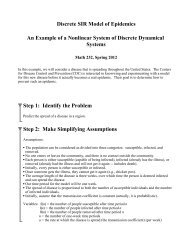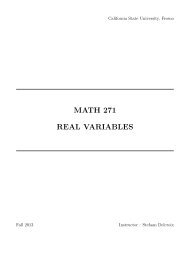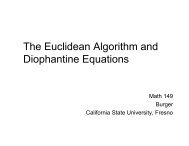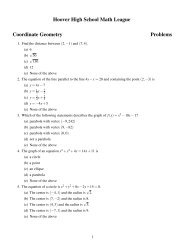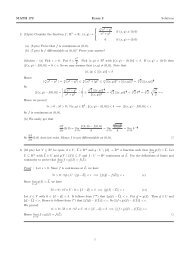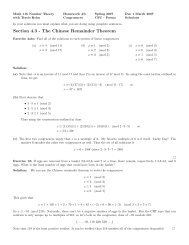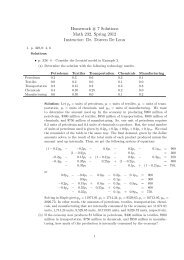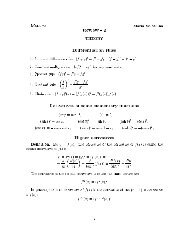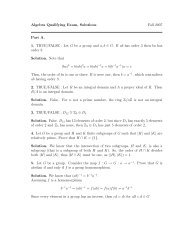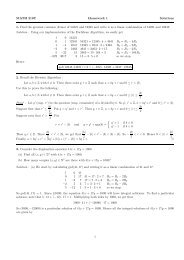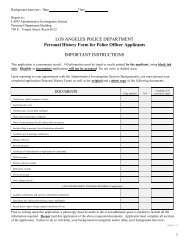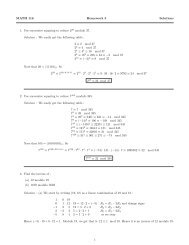MATH 251 Homework 6 Solutions 1. Let G be a finite group, N ¢ G ...
MATH 251 Homework 6 Solutions 1. Let G be a finite group, N ¢ G ...
MATH 251 Homework 6 Solutions 1. Let G be a finite group, N ¢ G ...
Create successful ePaper yourself
Turn your PDF publications into a flip-book with our unique Google optimized e-Paper software.
<strong>MATH</strong> <strong>251</strong> <strong>Homework</strong> 6 <strong>Solutions</strong><strong>1.</strong> <strong>Let</strong> G <strong>be</strong> a <strong>finite</strong> <strong>group</strong>, N ✂ G and n ∈ N such that G/N has an element of order n. Prove that G hasan element of order n.Proof : <strong>Let</strong> x ∈ G/N with |x| = n. Then x = gN for some g ∈ G. Since G is <strong>finite</strong>, we have that g has<strong>finite</strong> order, say m. Note thatx m = (gN) m = g m N = eN = NBy Proposition <strong>1.</strong>7(a), we have that n|m. So m = nk for some k ∈ Z. By Proposition <strong>1.</strong>7(b), g k is an|g|element in G of ordergcd(k, |g|) = mgcd(k, m) = m k = n.✷2. <strong>Let</strong> G <strong>be</strong> a <strong>group</strong> and H 1 , H 2 <strong>finite</strong> sub<strong>group</strong>s of G. Prove that |H 1 H 2 | = |H 1||H 2 ||H 1 ∩ H 2 | .Note that H 1 H 2 does NOT need to <strong>be</strong> a sub<strong>group</strong> of G.Proof : We define a relation ∼ on H 1 × H 2 by (x 1 , x 2 ) ∼ (y 1 , y 2 ) ⇐⇒ x 1 x 2 = y 1 y 2 . Then ∼ is anequivalence relation. Clearly, there are |H 1 H 2 | different equivalence classes. Pick x 1 ∈ H 1 and x 2 ∈ H 2 .What is the size of the equivalence containing (x 1 , x 2 )? Pick (h 1 , h 2 ) ∈ H 1 × H 2 with (h 1 , h 2 ) ∼ (x 1 , x 2 ).Then h 1 h 2 = x 1 x 2 and so h 2 x −12 = h −11 x 1 ∈ H 1 ∩ H 2 . Hence there exists g ∈ H 1 ∩ H 2 with h 2 x −12 = g =h −11 x <strong>1.</strong> So (h 1 , h 2 ) = (x 1 g −1 , gx 2 ). Conversely, if g ∈ H 1 ∩ H 2 , then (h 1 , h 2 ) := (x 1 g −1 , gx 2 ) ∈ H 1 × H 2and h 1 h 2 = (x 1 g −1 )(gx 2 ) = x 1 x 2 . So (h 1 , h 2 ) ∼ (x 1 , x 2 ). Hence the equivalence class containing (x 1 , x 2 )is the set {(x 1 g −1 , gx 2 ) | g ∈ H 1 ∩ H 2 }, which has exactly |H 1 ∩ H 2 | elements. So |H 1 ||H 2 | = |H 1 × H 2 | =|H 1 H 2 ||H 1 ∩ H 2 |. ✷3. <strong>Let</strong> G <strong>be</strong> a <strong>finite</strong> p-<strong>group</strong> of order p n , 0 ≤ i < n and H ≤ G of order p i . Prove that H is contained insome sub<strong>group</strong> of G of order p i+1 .hint : Use induction on |G|. <strong>Let</strong> N ≤ Z(G) with |N| = p (why is this possible). Then N ✂ G (why).Consider the cases N ≤ H and N ≰ H.Proof : We prove the following statement by induction on n :If G is a <strong>finite</strong> p-<strong>group</strong> of order p n and H is a proper sub<strong>group</strong> of G then G has a sub<strong>group</strong> Kof order p|H| containing H.If H = 1 then G has a sub<strong>group</strong> K of order p by Proposition 5.6 and so H = 1 ≤ K (this also provesthe base case ‘n = 1’). So we may assume that |H| = p i for some 0 < i < n. Since |G| ≠ 1, wehave that Z(G) ≠ 1 by Proposition 5.2. By Proposition 5.6, Z(G) has a sub<strong>group</strong> N of order p. Sinceany sub<strong>group</strong> of Z(G) is a normal sub<strong>group</strong> of G, we have that N ✂ G. Suppose first that N ≰ H.Then N ∩ H = <strong>1.</strong> Note that H < K := HN ≤ G by the Second Isomorphism Theorem. By Ex.#2, |HN| = |H||N||H ∩ N| = pi · p= p i+1 = p|H|. Suppose next that N ≤ H. Note that H/N ≤ G/N,1|H/N| = p i−1 and |G/N| = p n−1 . Since |G/N| < |G|, we get that by induction that G/N has a sub<strong>group</strong>H ∗ of order p|H/N| = p · p i−1 = p i containing H/N. Then H ∗ = K/N by Proposition <strong>1.</strong>24 whereN ≤ K ≤ G. Note that p i = |H ∗ | = |K/N| = |K|pand so |K| = pi · p = p i+1 = p|H|. Moreover, H ≤ Ksince H/N ≤ H ∗ = K/N.✷1
4. <strong>Let</strong> G <strong>be</strong> a <strong>finite</strong> <strong>group</strong>, p a prime dividing |G| and N ✂ G.(a) Prove that Syl p (N) = {S ∩ N | S ∈ Syl p (G)}.(b) Prove that Syl p (G/N) = {SN/N | S ∈ Syl p (G)}.Proof : (a) <strong>Let</strong> T ∈ Syl p (N). Then T is a p-sub<strong>group</strong> of G. By the Third Sylow Theorem, there existsS ∈ Syl p (G) with T ⊆ S. Hence T ≤ S ∩ N. Note that S ∩ N is a p-sub<strong>group</strong> of N since S ∩ N ≤ N,S ∩ N ≤ S and so |S ∩ N| divides |S|, which is a power of p. But T is a maximal p-sub<strong>group</strong> of N (sinceT ∈ Syl p (N)). Hence T = S ∩ N. So Syl p (N) ⊆ {S ∩ N | S ∈ Syl p (G)}.<strong>Let</strong> S ∈ Syl p (G). We proved that there exists S 1 ∈ Syl p (G) such that S 1 ∩ N ∈ Syl p (N) (indeed, letT ∈ Syl p (N); then T = S 1 ∩ N for some S 1 ∈ Syl p (G)). By the Second Sylow Theorem, S = S g 1 for someg ∈ G. Hence (S 1 ∩ N) g = S g 1 ∩ N g = S ∩ N since N ✂ G. In particular, |S ∩ N| = |(S 1 ∩ N) g | = |S 1 ∩ N|.Since S 1 ∩N ∈ Syl p (N) and S∩N is a p-sub<strong>group</strong> of N with |S∩N| = |S 1 ∩N|, we get that S∩N ∈ Syl P (N).So {S ∩ N | S ∈ Syl p (G)} ⊆ Syl p (N).(b) <strong>Let</strong> S ∈ Syl p (G). By the Second Isomorphism Theorem, SN/N ∼ = S/(S ∩ N), which is a p-<strong>group</strong> since|S/(S ∩ N)| divides |S|. Soord p (|SN/N|) = ord p (|S/(S ∩ N)|) = ord p (|S|/|S ∩ N|) = ord p (|S|) − ord p (|S ∩ N|)Since S ∈ Syl p (G), ord p (|S|) = ord p (|G|). By (a), S ∩ N ∈ Syl p (N) and so ord p (|S ∩ N|) = ord p (|N|).Henceord p (|SN/N| = ord p (|S|) − ord p (|S ∩ N|) = ord p (|G|) − ord p (|N|) = ord p (|G|/|N|) = ord p (|G/N|)Since SN/N is a p-sub<strong>group</strong> of G/N and |SN/N| is the size of a Sylow p-sub<strong>group</strong> of G/N, we get thatSN/N ∈ Syl p (G/N). So {SN/N | S ∈ Syl p (G)} ⊆ Syl p (G/N).<strong>Let</strong> X ∈ Syl p (G/N). <strong>Let</strong> S ∈ Syl p (G). We proved that SN/N ∈ Syl p (G/N). By the Second SylowTheorem, X = (SN/N) x for some x ∈ G/N. Then x = gN for some g ∈ G andX = (SN/N) gN = {(gN) −1 (sN)(gN) | s ∈ S} = {g −1 sgN | s ∈ S} = S g N/NNote that S g ∈ Syl p (G). So Syl p (G/N) ⊆ {SN/N | S ∈ Syl p (G)}.✷5. <strong>Let</strong> G <strong>be</strong> a <strong>group</strong> of order 700.(a) Prove that G is not simple.(b) Prove that G has a sub<strong>group</strong> of order 14.⎧⎨ n 2 ∈ {1, 5, 7, 25, 35, 175}Proof : Note that 700 = 2 2 · 5 2 · 7. We easily get that n 5 = 1⎩n 7 ∈ {1, 50}(a) Since n 5 = 1, G has exactly one Sylow 5-sub<strong>group</strong>, which has to <strong>be</strong> normal in G. So G is not simple.(b) <strong>Let</strong> P ∈ Syl 7 (G). Suppose first that n 7 = <strong>1.</strong> Then P ✂ G. By Proposition 5.6, there exists H ≤ G|P ||H|with |H| = 2. Then P H ≤ G and |P H| =|P ∩H|= 7·21= 14 (note that |P ∩ H| = 1 since it divides|P | = 7 and |H| = 2). Suppose next that n 7 = 50. Then |N G (P )| = 70050 = 14. ✷2
6. <strong>Let</strong> G <strong>be</strong> a <strong>group</strong> of order 616.(a) Prove that G is not simple.(b) Prove that G has a sub<strong>group</strong> of order 77.⎧⎨ n 2 ∈ {1, 7, 11, 77}Proof : Note that 616 = 2 3 · 7 · 1<strong>1.</strong> We easily get that n 7 ∈ {1, 8, 22}⎩n 11 ∈ {1, 56}(a) Suppose that n 7 ≠ 1 and n 11 ≠ <strong>1.</strong> Then G contains 56 · (11 − 1) = 560 elements of order 11 and atleast 8 · (7 − 1) = 48 elements of order 7. Since 616 − 560 − 48 = 8, we see that G has only one Sylow2-sub<strong>group</strong> and that n 7 = 8. So n 2 = <strong>1.</strong>Hence n p = 1 for some p ∈ {2, 7, 11}. So G is not simple.(b) Suppose first that n 7 = 1 or n 11 = <strong>1.</strong> <strong>Let</strong> P ∈ Syl 7 (G) and Q ∈ Syl 11 (G). Then P ✂ G or Q ✂ G.|P ||Q|Hence P Q ≤ G and |P Q| =|P ∩Q| = 7·111= 77. Suppose next that n 7 ≠ 1 and n 11 ≠ <strong>1.</strong> By (a), n 7 = 8.<strong>Let</strong> P ∈ Syl 7 (G). Then |N G (P )| = 6168 = 77. ✷7. Prove that there are no simple <strong>group</strong>s of order 4125, 4095, 525 or 400.⎧⎨ n 3 ∈ {1, 25, 55, 1375}Proof : (a) <strong>Let</strong> G <strong>be</strong> a <strong>group</strong> of order 4125 = 3 · 5 3 · 1<strong>1.</strong> We easily get that n 5 ∈ {1, 11}⎩n 11 ∈ {1, 375}Suppose that G is simple. Then n p ≠ 1 for p = 3, 5, 1<strong>1.</strong> So n 5 = 1<strong>1.</strong> By the Small Index Argument, |G|divides 11!, a contradiction since ord 5 (11!) = 2 and ord 5 (|G|) = 3. So G is not simple.⎧n 3 ∈ {1, 7, 13, 91}⎪⎨(b) <strong>Let</strong> G <strong>be</strong> a <strong>group</strong> of order 4095 = 3 2 n · 5 · 7 · 13. We easily get that 5 ∈ {1, 21, 91}n 7 ∈ {1, 15}⎪⎩n 13 ∈ {1, 105}Suppose that G is simple. Then n p ≠ 1 for p = 3, 5, 7, 13. So n 7 = 15 and n 13 = 105. <strong>Let</strong> P ∈ Syl 7 (G).Then |N G (P )| = 409515= 273 = 3 · 7 · 13. <strong>Let</strong> Q ∈ Syl 13 (N G (P )). A <strong>group</strong> of order 273 has only oneSylow 13-sub<strong>group</strong> and so Q ✂ N G (P ). Hence N G (P ) ≤ N G (Q). But |Q| = 13. So Q ∈ Syl 13 (G).Hence |N G (Q)| = 4095105 = 39, a contradiction since N G(P ) ≤ N G (Q) but |N G (P )| = 273 does not divide|N G (Q)| = 39. So G is not simple.⎧⎨ n 3 ∈ {1, 7, 25, 175}(c) <strong>Let</strong> G <strong>be</strong> a <strong>group</strong> of order 525 = 3 · 5 2 · 7. We easily get that n 5 ∈ {1, 21}⎩n 7 ∈ {1, 15}Suppose that G is simple. Then n p ≠ 1 for p = 3, 5, 7. So n 5 = 21 and n 7 = 15. <strong>Let</strong> P ∈ Syl 7 (G).Then |N G (P )| = 5<strong>251</strong>5 = 35. <strong>Let</strong> Q ∈ Syl 5(N G (P )). A a <strong>group</strong> of order 35 has only one Sylow 5-sub<strong>group</strong>and so Q ✂ N G (P ). Hence N G (P ) ≤ N G (Q). <strong>Let</strong> Q ∗ ∈ Syl 5 (G) with Q ≤ Q ∗ . Since |Q| = 5 and|Q ∗ | = 25, we get that [Q ∗ : Q] = 5 and so Q ✂ Q ∗ . Hence Q ∗ ≤ N G (Q). So N G (P )Q ∗ ⊆ N G (Q).But |N G (P )Q ∗ | = |N G(P )||Q ∗ | 35·25|N G (P )∩Q ∗ |=|N G (P )∩Q ∗ |≥ 175. Hence |N G (Q)| ≥ 175 and [G : N G (Q)] ≤ 5<strong>251</strong>75 = 3.Since |G| does not divide 3!, we get that N G (Q) = G by the Small Index Argument. But then Q ✂ G, acontradiction. Hence G is not simple.{(d) <strong>Let</strong> G <strong>be</strong> a <strong>group</strong> of order 400 = 2 4 · 5 2 n2 ∈ {1, 5, 25}. We easily get thatn 5 ∈ {1, 16}Suppose that G is simple. Then n p ≠ 1 for p = 3, 5. So n 5 = 16. Since |G| does not divide 5!, we getthat n 3 = 25 by the Small Index argument. Suppose first that P ∩ Q = 1 for all P, Q ∈ Syl 5 (G) withP ≠ Q. Then G has 16 · (25 − 1) = 384 elements whose order is a power of 5. Since 400 − 384 = 16,we get that G has only one Sylow 2-sub<strong>group</strong>, a contradiction. Hence there exist P, Q ∈ Syl 5 (G) with3
P ≠ Q and P ∩ Q ≠ <strong>1.</strong> So |P ∩ Q| = 5. Hence [P : P ∩ Q] = 5 = [Q : P ∩ Q]. So P ∩ Q ✂ P, Q. Hence|P ||Q|P, Q ≤ N G (P ∩ Q). So P Q ⊆ N G (P ∩ Q). But |P Q| =|P ∩Q| = 25·255= 125. Hence |N G (P ∩ Q)| ≥ 125and [G : N G (P ∩ Q)] ≤ 400125 < 4. Since |G| does not divide 4!, we get that N G(P ∩ Q) = G by the SmallIndex Argument. So P ∩ Q ✂ G, a contradiction. So G is not simple.4



